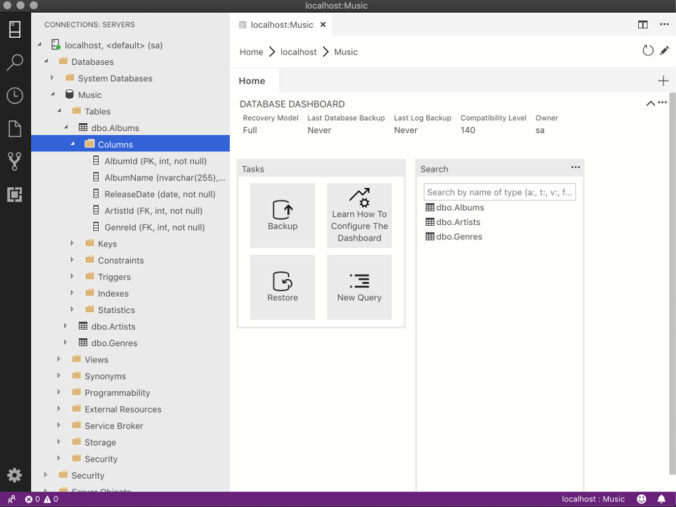

Created Reports in your ‘shared dataset file’ and now want to move them to a report pbix file. Power BI Can you use an inactive join for a slicer (USERELATIONSHIP).
#Azure data studio snowflake pro#
Power BI Premium Deployment Pipelines and Sub Workspaces – Publishing a live report to a pro workspace from a premium workspace.Azure SQL Database Dev to Production Part 4.Power BI – reporting on Items NOT in a filter.Power BI October 21 Updates GetUserArtifactAccessAsAdmin API through to PowerShell.Power BI DAX – Create a percentage across days of week (ALLEXCEPT.Investigating the Power BI Scanner APIs Part 1.Power BI Admin APIs to return a list of email subscriptions.Power BI February 2022 Updates Dynamic M Query Parameters.Azure Logic App – Copying a file from Sharepoint to a Data Lake.Power BI – App Viewers can’t see the data in the report.Power BI – Deployment Pipeline Quick Tips – Setting dataflow Environment sources and Publishing (Direct Query) Datasets containing multiple Datasets.Power BI Composite Modelling (Multiple datasets Report) – Couldn’t load the data for this visual.Power BI Concatenating two measures together under one column header for a table display.Power Query Editor – Avoiding the creation of all the helper Queries and Folders in power BI.Although there are no issues with the snowflake, this is a clear win for the star. So we created a Star schema and sped our reports up.

We have a tiny amount of data but if you have a lot of data this will really make a difference Great, you can immediately see that the STAR was quicker. I have created a blank page to start from So lets see how they match up usingPerformance Analyser (You may have to turn it on in Options and Settings – Options – Diagnostics) I created a new measure on the new Event and Schedule Dimension # Events (STAR) = DISTINCTCOUNT('Event And Schedule')Īnd I now have the same visuals against the Star and the Snowflake The Fact is connected to the Event and Schedule by the Event ID the dimension holds a short fat table (One date)Īnd the fact table is long and thin (The date ID is in the fact table many times)ĭenormalise the Event and Agenda tables looks like this Notice the the dim is on the one side and the Many is on the fact side. Lets have a think about how 1 to many happens using the date dimension as a good example But, how would you change this into a snowflake Schema? Fact table 1 to many At this point it still feels like Snowflake is still a good option. The snowflake seems to be doing everything that it needs to do. There are 12 Agenda ItemsĪnd again, the new measure shows us correctly the number of agenda items. I created a Measure in the fact table that does a distinct count of the Event Detail IDs # Events = DISTINCTCOUNT('Dim Event Details')Īgain, this works a treat. So the next question the user wants is, how many agenda items are there per event? It Sums to the 2 event (Which is correct for the number of events but is not correct for the number of Agenda items) However the metric looks a little confusing if dont understand the dataįor example, the table with EventDetail and Event should sum to 12 (the 12 Agenda items) but it doesn’t. When you bring in data from the Snowflake dimension, it still shows the 2 event metric. This is an interesting look at the results. Seperating the fact and dim when the relationship is a 1 to 1 is knows as a If you however leave the model as one to one, both direction, it makes no difference to the results. I have changed it to 1 to many to get the single direction filter and the fact that the event table snowflaked off from events creates 1 to many. Moving the facts into a Fact table and the descriptions into a dim table in a 1 to 1 relationship is called creating a Degenerate table the relationships started as both direction. Lets see how it would work in Power BIįact to Dim is one to one. Its very easy to create a snowflake schema for this. We are looking at Events and these events consist of Agenda items. This is very similar to something I am working on at the moment. Also, how can I change my thinking on Snowflake to STAR So i wanted to have a look at this and see why I do it and what it actually means for Power BI. I however, do seem to use snowflake schemas and it seems that even these aren’t recommended for Power BI. Power BI prefers the STAR Schema model comprising of a fact table and Dimensions providing all the filters for the metrics We have already spoken about Steering clear from flat files. One was from the session related to DAX and Power BI Models. I attended the Power BI conference from and got so many great ideas on the 16th June


 0 kommentar(er)
0 kommentar(er)
